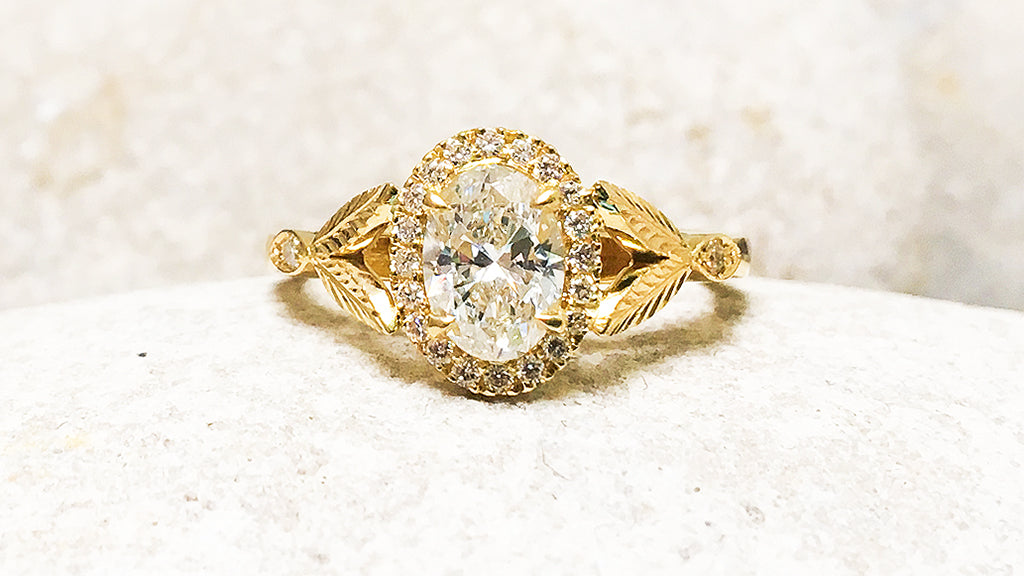Your Cart is Empty
A cluster is a busy arrangement of small gemstones, set close to one another for maximum sparkle and surface area. Historically, the cluster setting was an opportunity for the couple on a modest budget to attain the highest possible carat weight and most impressive possible finish.
The prototypical cluster setting features a round or oval-cut central gem enveloped by a sparkling halo of smaller stones. However, the cluster blueprint has ushered in many a variation over the years, each encapsulating the trends of the time. To help you navigate this host of options, this blog post explores the cluster setting’s variety of faces, summarising pros and cons so you can decide whether this star-studded style is right for you.

Cluster rings from this time period often boasted rose-like designs, with a round centrepiece and blackened metal used to contrast with the gemstones. Gemstones were relatively sparse, metalwork was prominent, and by today’s standards these early cluster rings were somewhat rudimentary.

The Victorian epoch was a time of development and growth. With the Industrial Revolution came a host of new inventions that would go on to change the world, from electricity to the lightbulb and various engines. Subsequently, jewellery manufacturing processes were refined. The metalwork of the cluster setting become more delicate, with daintier prongs and gemstones set much closer to one another than those of yesteryear. Adhering to the fundamental halo arrangement, the Victorian cluster can really be considered the standard from which succeeding cluster styles evolved.

Encapsulating the whimsical elegance of this very brief period in design history, Edwardian cluster rings were even more ethereal than their predecessors. Queen Alexandra’s love of flowers fuelled a surge of jewels with floral motifs, namely the Edwardian daisy ring that has since been hailed a design classic. In fact, it’s a concept that inspired our brand new Daisy Collection! With its rosette of gemstone petals, round and equal in size, the daisy ring was simple but effective.
At this time, the arts were flourishing and jewellers experimenting widely with platinum for the first time. Its strength and durability compared to gold enabled them to create more intricate jewels, introducing details such as millegrain - the tiny rows of platinum beads that can often be seen lending extra sparkle to Edwardian cluster rings.

The Art Deco period was symbolic of evolution; of severing ties with the wartime past and hurtling towards the future. Geometric lines replaced organic naturalism; graceful nuances rejected in favour of fearless boldness. The cluster broadened by definition, quickly embracing angular gemstones, half-halos and asymmetric patterns. A trend for clean lines saw gemstones set ever closer to one another, leaving as little free space as possible.


In this day and age the cluster ring can take on infinite forms, sometimes inspired by these past templates; other times, bucking all familiar conventions.
One of the most popular cluster trends in the contemporary context is the combination of coloured gemstones and white diamonds, the perfect example being Princess Diana’s famed engagement ring – now worn by the Duchess of Cambridge – which encircles an oval blue sapphire in a halo of twinkling diamonds.
The ‘halo’ is a broad umbrella encompassing a variety of cluster styles - from Georgian roses to Victorian blooms, Edwardian daisies and Princess Diana’s iconic nimbus of gems. Whichever form it takes, the halo engagement ring is born from a desire to make an impact, its ring of smaller gemstones there with the primary purpose of amplifying their centrepiece.

Wow factor:Beauty is of course in the eye of the beholder, but cluster settings are consistent in their ability to catch attention. Characterised by a capacity to reflect light at almost every angle, extreme sparkle is guaranteed.
Opportunity:The versatile nature of the cluster setting leaves plenty of room for adaptation, enabling you to have fun with gemstone colours, sizes and arrangements; perfect for the client who has their heart set on something unique.
Timelessness:A concept that’s been enjoyed for centuries, the cluster ring often carries an air of wisdom and antiquity, making it a timeless heirloom to be enjoyed for generations.
Optimisation:Not only does a halo cleverly create the illusion of a larger centre stone, but cluster settings are a crafty means of attaining a high carat weight for a fraction of the solitaire price tag. This doesn’t mean that the cluster ring is inferior; just that a scattering of smaller gemstones is far more affordable than one big rock.

Upkeep:With an abundance of gemstones and crevices comes a higher risk of dirt and damage. Cluster settings must be cleaned frequently and checked regularly by a stone-setter to ensure no loose elements.
Profile:Cluster settings are often bulky and low-sitting, making it slightly trickier to find a straight wedding band in the future that will sit perfectly flush.
